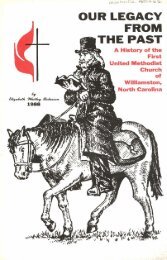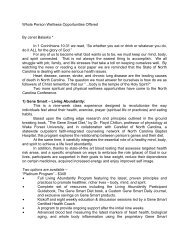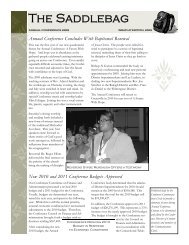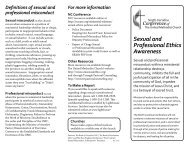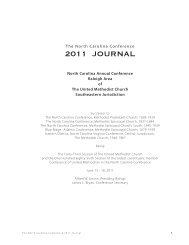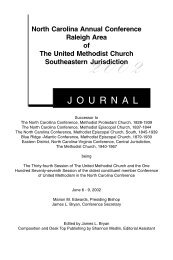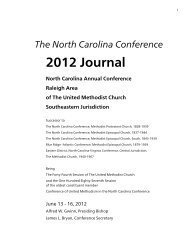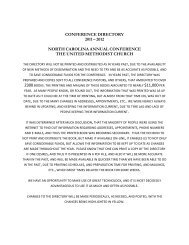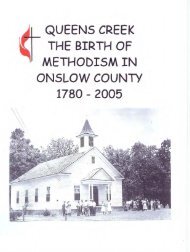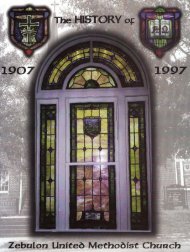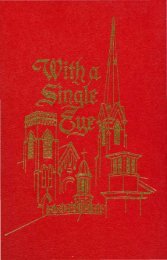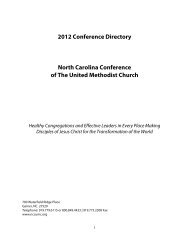A Journey Back: Historic Oak Grove United Methodist Church, 2007
A Journey Back: Historic Oak Grove United Methodist Church, 2007
A Journey Back: Historic Oak Grove United Methodist Church, 2007
Create successful ePaper yourself
Turn your PDF publications into a flip-book with our unique Google optimized e-Paper software.
The Beginning of Methodism in Northampton County<br />
Before churches were built in the county, ministers and laymen traveled the countryside on horseback staying in private homes<br />
and preaching the Gospel to anyone they could reach. Their main goal was to establish churches. Because their route encompassed<br />
a circuit or geographical area in which one or more churches were located, they were referred to as circuit riders. Today we call<br />
these circuits, charges.<br />
The first churches in America were <strong>Methodist</strong> Episcopal churches and closely tied to the <strong>Church</strong> of England and the Anglican<br />
church. Between 1763 and 1775 Devereux Jarratt, an Anglican minister from Virginia and a forerunner of Methodism, frequently visited<br />
Northampton County. By 1778 through his efforts, the Roanoke <strong>Methodist</strong> Circuit had been established. Upon visiting the county in 1788,<br />
Bishop Thomas Asbury said, "the <strong>Methodist</strong>s of Northampton County were known to have God and Christ in their hearts." By the<br />
beginning of the 19th century meeting houses and camp meetings became the desired method of teaching the "remission of sin." Camp<br />
meetings lasted several days and carriages and wagons often met riverboats to take passengers inland for these revivals.<br />
The first <strong>Methodist</strong> Meeting House in Northampton County was Concord near Seaboard. In 1783 Howell Myrick of Brunswick<br />
County, Virginia transferred land to Matthew Myrick, Nathanial Mason, Henry King and John Moore. Myrick and Mason were from<br />
Brunswick County, Virginia. King and Moore from Northampton County. By 1793 covenants were signed to build a church.<br />
A memorandum dated June 5, 1793 specified that the preachers who use the house may use it only so long as they "expound the word of<br />
God and teach the doctrines contained in John Wesley's notes on the New Testament and his four volumes of sermons."<br />
The second <strong>Methodist</strong> <strong>Church</strong> in Northampton County was Rehoboth Chapel. Eliphas Lewis gave the land to the church in 1798.<br />
The land was then deeded to the first trustees: Richard Whitaker, William Brewer, Absolam Grant, William Grant and Matthew Griffin. The<br />
first chapel was a simple structure without paint or plaster. The chapel was organized by Richard Whitaker and was rebuilt in 1857. That<br />
same year the name chapel changed to church. Rehoboth <strong>Church</strong> stands today.<br />
The third <strong>Methodist</strong> <strong>Church</strong> in Northampton County was Pinners near Rich Square. Two versions of who donated the land exist.<br />
One version says Joseph Pinner gave the land to build this church that bears his name. The other version says that the land was donated by<br />
Jeremiah Carter, whose plantation adjoined the church property. The original church was located at the junction of Eaglestown, a<br />
community east of Rich Square, and highway 258. This church was built before 1820 but the exact date is not known. Pinners was<br />
officially closed in 1971. Today the church is maintained as an historic church of the North Carolina Conference of The <strong>United</strong> <strong>Methodist</strong><br />
<strong>Church</strong>.<br />
The fourth <strong>Methodist</strong> <strong>Church</strong> in Northampton County was <strong>Oak</strong> <strong>Grove</strong> and is the subject of this book. David H. Clements gave the<br />
land for the original church in 1821. The deeds for <strong>Oak</strong> <strong>Grove</strong> <strong>Church</strong> are found within these pages and contain the names of many families<br />
who are still living in the area.<br />
Source: Footprints in Northampton, Northampton Bicentennial Committee, 1976, pp. 7, 9, 115.<br />
5



